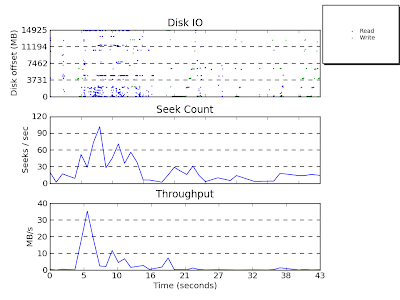It requires matplotlib, python and the numpy module - on Ubuntu download and install these packages using:
sudo apt-get install python python-matplotlib python-numpy
and then get the seekwatcher source and extract seekwatcher from the source package and you are ready to run the seekwatcher python script.
Seekwatcher also can general animations of I/O patterns which also improves visualisation and understanding of I/O operations over time.
To use seekwacher, first start a blktrace capture:
blktrace -o trace -d /dev/sda
next kick off the test you want to analyse and when that's complete, kill blktrace. Next run seekwatcher on the blktrace output:
seekwatcher -t trace.blktrace -o output.png
..and this generates a png file output.png. Easy!
Attached is the output from a test I just ran on my HP Mini 1000 starting up the Open Office word processor:
 One can generate a movie from the same data using:
One can generate a movie from the same data using:seekwatcher -t trace.blktrace -o open-office.mpg --movie
The generated movie is below:
There are more instructions on other ways to use seekwatcher on the seekwatcher webpage. All in all, a very handy tool - kudos to Chris Mason.
Thanks for posting this, I've been wondering how to analyse I/O for a while.
ReplyDelete@Pepsiman, glad it helped!
ReplyDeleteThanks for posting it. It helps a lot.
ReplyDelete